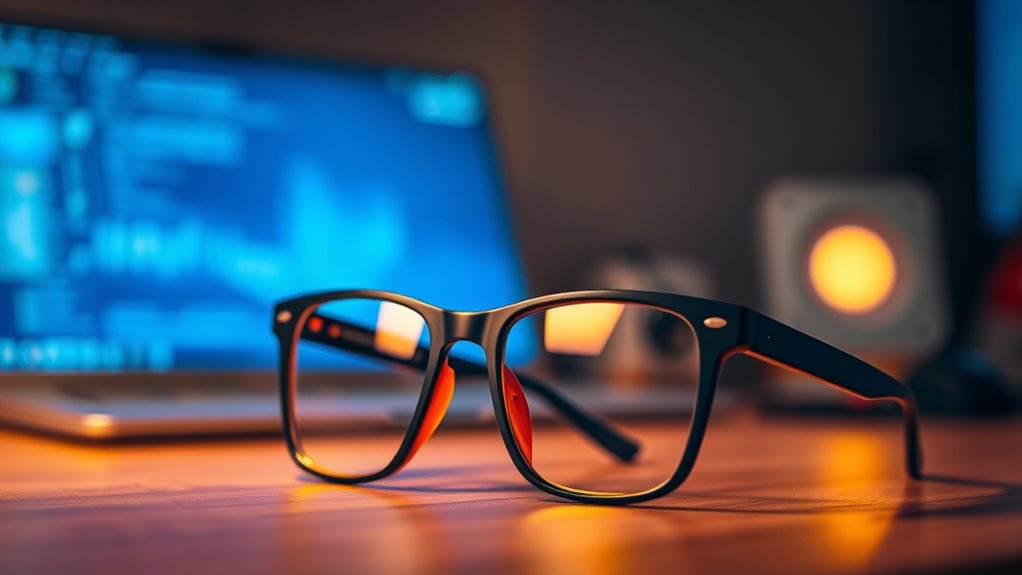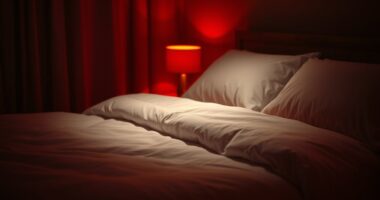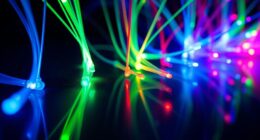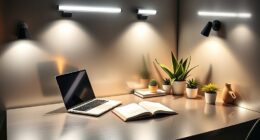Blue-blocking glasses filter out specific blue light wavelengths, helping reduce eye strain, glare, and potential sleep disruptions caused by screens. Scientific studies show mixed results—some suggest they improve sleep quality and visual comfort, while others find minimal effects. Their benefits likely depend on individual habits and timing of use. If you keep exploring, you’ll discover how these glasses compare to other strategies and what the latest research reveals about their true effectiveness.
Key Takeaways
- Scientific evidence suggests blue-blocking glasses can reduce eye strain, glare, and improve visual comfort during prolonged screen use.
- They may help mitigate circadian rhythm disruptions by filtering blue light, supporting better sleep quality.
- Research results are mixed; some studies show benefits, while others indicate minimal or no significant impact.
- Limitations include small sample sizes, subjective reports, and potential biases, requiring more rigorous, long-term studies.
- Blue-blocking glasses are most effective when combined with overall light management and sleep hygiene strategies.
What Are Blue-Blocking Glasses and How Do They Work?
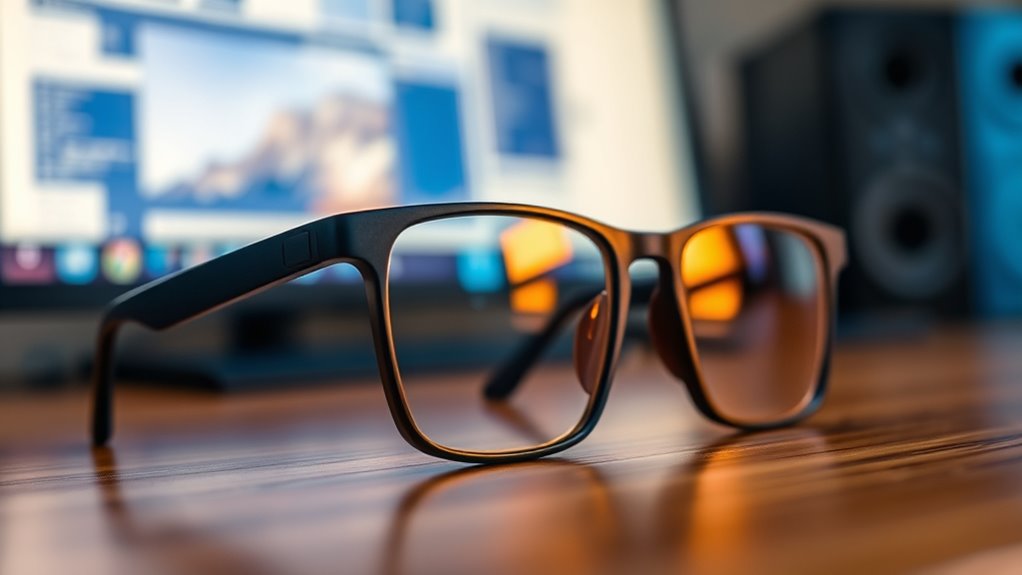
Blue-blocking glasses are specially designed eyewear that filter out a portion of blue light emitted by screens and artificial lighting. They achieve this through spectral filtering, which selectively absorbs or reflects specific wavelengths of light, primarily in the blue spectrum. This process helps reduce the eye strain often associated with prolonged screen use. By improving visual ergonomics, these glasses aim to make digital viewing more comfortable and less fatiguing. When you wear them, they minimize glare and harsh reflections, easing your eyes during extended periods of screen time. The spectral filtering feature targets the most problematic blue light wavelengths, balancing clarity with protection. Overall, blue-blocking glasses work by optimizing how your eyes process light, promoting comfort and potentially supporting better visual health. Incorporating knowledge of industry trends can help users choose the most effective options for their needs.
The Science Behind Blue Light and Digital Devices

Blue light from digital devices can disrupt your circadian rhythms, making it harder to fall asleep. These screens emit high levels of blue light that can interfere with your body’s natural sleep signals. Understanding how this exposure affects your sleep cycle helps you decide if blue-blocking glasses are worth trying. Additionally, using headphones with certain features can help reduce blue light exposure by enabling audio cues or blocking out ambient light during screen time.
Blue Light and Circadian Rhythms
Although many people use digital devices late into the evening, exposure to blue light from screens can disrupt your body’s natural sleep-wake cycle. Blue light affects melatonin regulation, making it harder for your body to signal bedtime. This interference hampers circadian entrainment—the process that syncs your internal clock with the day-night cycle. When circadian rhythms are off, you may experience poor sleep quality and fatigue. To understand how blue light impacts your rhythms, consider these points:
- It suppresses melatonin production at night
- Disrupts the timing of your sleep cycle
- Alters core body temperature rhythms
- Affects alertness and cognitive function
- Can shift your circadian phase later, delaying sleep onset
Recognizing these effects helps you see why managing blue light exposure is key to maintaining healthy circadian rhythms. Additionally, exposure to blue light during evening hours can lead to disrupted sleep patterns, further impacting overall health and well-being.
Digital Screen Emissions
Digital screens emit a significant amount of blue light, which penetrates your eyes and interacts with your visual and circadian systems. The color temperature of screens varies, often shifting from warmer tones during evening hours to cooler tones during the day, impacting your exposure. High color temperatures mean more blue light, which can influence alertness and sleep quality. Additionally, flicker reduction technologies help minimize screen flickering that can cause eye strain and fatigue. Modern displays increasingly incorporate flicker-free modes, making viewing more comfortable. Understanding these emissions helps you assess how digital devices affect your eye health and sleep patterns. While blue light plays a role, managing screen brightness, using flicker reduction, and adjusting color temperature are practical steps to reduce potential harm. Incorporating ergonomic adjustments can further enhance comfort during prolonged screen use.
Effects of Blue Light on Sleep and Circadian Rhythms
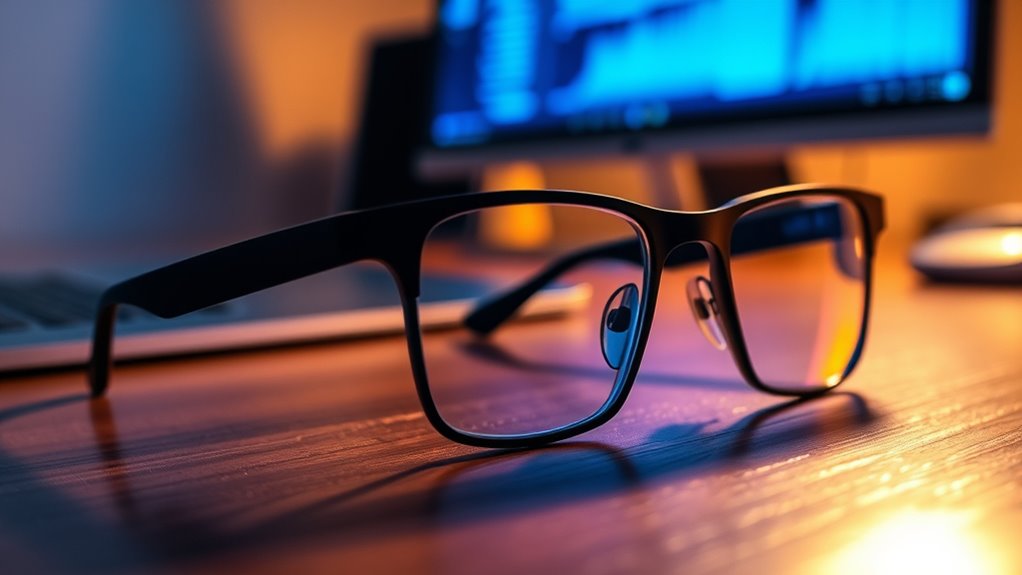
Research shows that exposure to blue light in the evening can considerably disrupt your sleep and circadian rhythms. When you’re exposed to blue light, your body suppresses melatonin production, making it harder to fall asleep. This melatonin suppression leads to circadian disruption, throwing off your internal clock. You might experience delayed sleep onset, poorer sleep quality, and decreased REM sleep. Additionally, blue light influences alertness levels, making it tough to wind down. Over time, this disruption can impact overall health, mood, and cognitive function. To better understand, consider these points:
- Blue light inhibits melatonin secretion
- Disrupts natural sleep-wake cycles
- Delays sleep onset and reduces sleep quality
- Impairs REM sleep and overall restfulness
- Contributes to long-term circadian misalignment
- Regular exposure to blue light can also impact mindfulness and emotional stability, further affecting your overall well-being.
Research on Blue-Blocking Glasses and Sleep Quality
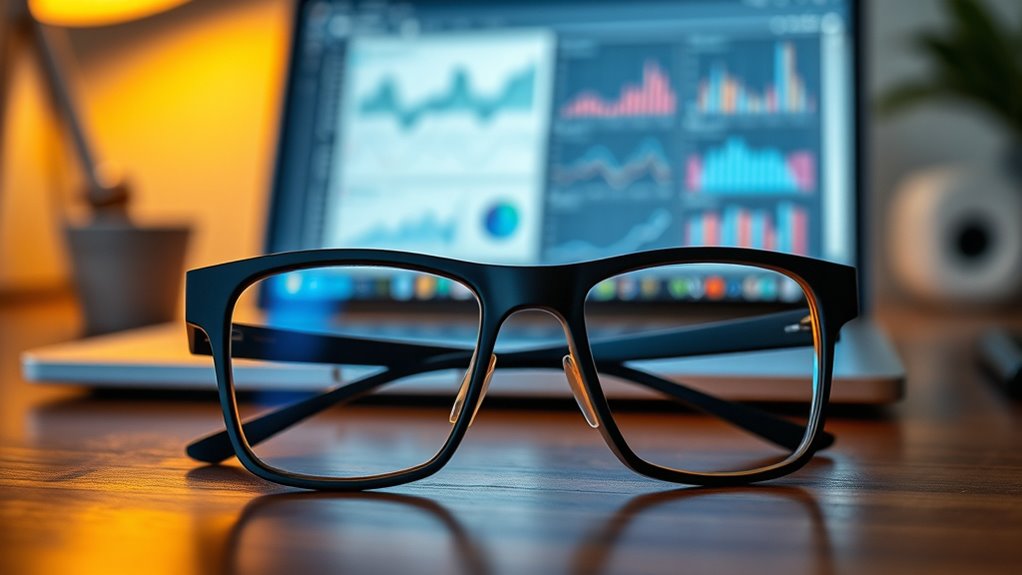
Studies examining the effects of blue-blocking glasses on sleep quality have produced mixed results. Some research shows that wearing these glasses in the evening can reduce melatonin suppression, helping you fall asleep faster and improve sleep duration. By filtering blue light, they may support your circadian rhythms and promote better sleep patterns. However, other studies find minimal or no significant improvements, suggesting that the benefits depend on individual differences and usage habits. Beyond sleep, blue-blocking glasses may also protect your eye health by reducing eye strain and minimizing potential damage from prolonged blue light exposure. While not a guaranteed fix, these glasses could be a helpful addition to your nightly routine, especially if you’re exposed to screens late at night. Additionally, glycolic acid benefits for skin are well-documented, promoting a radiant complexion and improving skin texture.
Impact on Digital Eye Strain and Visual Comfort
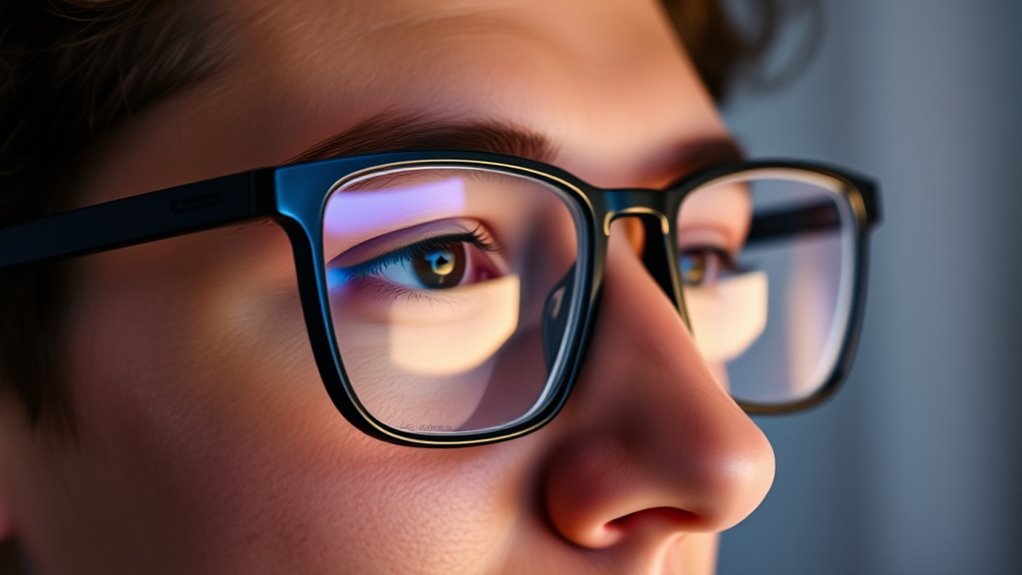
Blue-blocking glasses can help alleviate digital eye strain by reducing glare and minimizing the discomfort caused by prolonged screen time. When you wear these glasses, you may notice improved visual comfort and less eye fatigue during long digital sessions. They work by filtering out blue light, which can contribute to eye strain and visual discomfort. Additionally, some studies suggest that tuning the display settings or using specialized glasses can further enhance these benefits screen time management.
Consider these benefits:
- Decreased glare from screens
- Reduced eye fatigue after extended use
- Enhanced visual clarity
- Less sensitivity to bright lights
- Improved overall comfort during screen time
While they may not eliminate all symptoms, blue-blocking glasses can be a helpful tool for managing digital eye strain and boosting your visual comfort, especially if you spend hours in front of screens daily.
Examining the Evidence for Mood and Cognitive Benefits
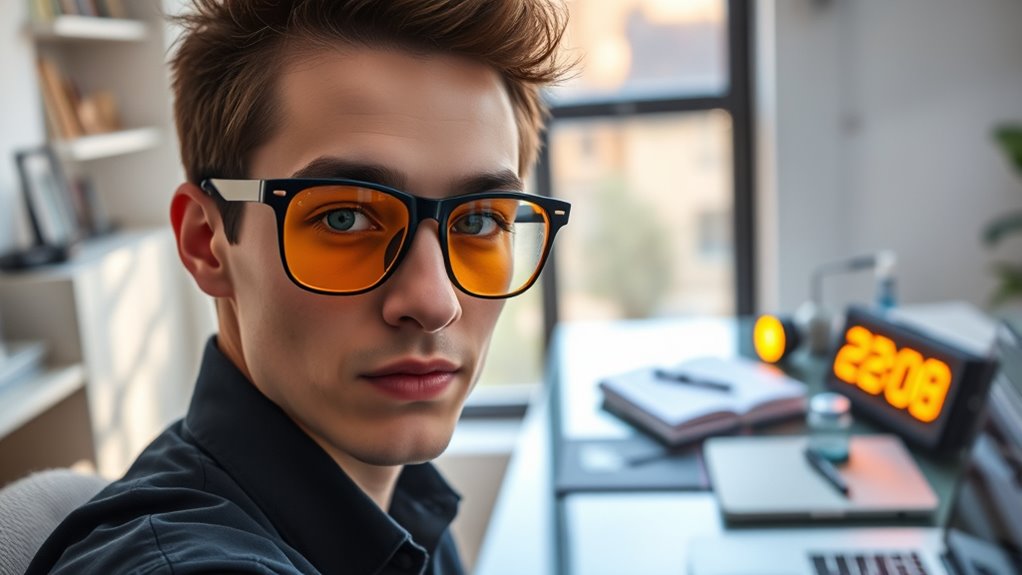
While the primary focus of blue-blocking glasses has been on eye health, emerging evidence suggests they might also influence mood and cognitive function. By reducing blue light exposure in the evening, these glasses can help limit circadian disruption, which often hampers sleep quality. Improved sleep, in turn, supports better mood regulation and cognitive performance. Some studies indicate that wearing blue blockers in the evening can lead to reductions in feelings of stress and anxiety, while enhancing alertness during daytime hours. Although research is still evolving, the connection between light exposure, circadian health, and mental well-being points to potential benefits. A vetted selection of blue-blocking glasses is recommended to ensure safety and efficacy. If you struggle with mood swings or cognitive fatigue, blue-blocking glasses may offer a simple way to support your mental health alongside your sleep hygiene.
Potential Limitations and Biases in Current Studies

Although emerging research suggests potential benefits of blue-blocking glasses, there are notable limitations and biases that can affect the reliability of current findings. Many studies face study design limitations, such as small sample sizes or lack of control groups, which reduce their generalizability. Researcher bias can also skew results, especially if investigators have a vested interest in positive outcomes. Additionally, some studies rely on subjective self-reports rather than objective measures, leading to possible inaccuracies. Publication bias might favor studies with favorable results, creating a skewed perception of effectiveness. Finally, short-term studies don’t account for long-term effects, leaving uncertainty about sustained benefits or risks. These factors highlight the need for more rigorous, unbiased research to truly assess blue-blocking glasses’ efficacy. Furthermore, understanding the vulnerabilities of AI models like GPT-4 emphasizes the importance of ongoing AI Security measures to ensure trustworthy information dissemination.
Comparing Blue-Blocking Glasses to Other Light Management Strategies
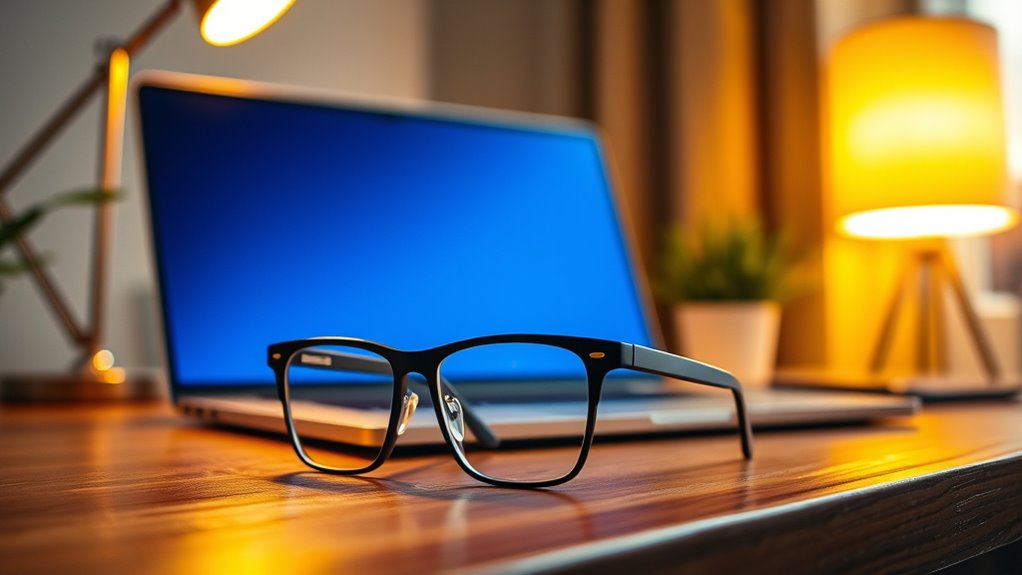
When considering light management, you have several options beyond blue-blocking glasses, like adjusting exposure to bright light, using alternative filters, or optimizing your sleep environment. Each strategy offers different benefits and limitations, so it’s important to evaluate which approach fits your lifestyle. Comparing these methods can help you find the most effective way to protect your eyes and improve your sleep. Incorporating sound design techniques, such as ambient sounds or tailored audio environments, can also enhance relaxation and sleep quality alongside light management strategies.
Blue-Blocking vs. Bright Light
Blue-blocking glasses are just one approach to managing light exposure, but they aren’t the only option. Bright light, especially during the day, helps regulate your circadian rhythm and boosts alertness, supporting overall eye health. Unlike blue-blocking glasses that filter blue light, exposure to natural or bright artificial light can be more effective in aligning your internal clock. Here are some strategies to contemplate:
- Increasing daytime sunlight exposure
- Using bright light therapy lamps
- Maintaining regular sleep schedules
- Limiting screen time before bed
- Adjusting indoor lighting for daytime activities
These methods can complement or sometimes outperform blue-light filtering glasses in promoting eye health and sleep quality, especially when used effectively during the day.
Alternative Light Filters
While blue-blocking glasses are popular, they’re just one of several strategies to manage light exposure and protect your eyes. Other options include screen filters, lighting adjustments, and wearable accessories. These alternatives often focus on balancing optical clarity and style, sometimes doubling as fashion accessories. For example, screen filters reduce blue light at the source, while dimming ambient lighting lessens eye strain. Here’s a quick comparison:
| Strategy | Effectiveness | Style & Clarity |
|---|---|---|
| Blue-blocking glasses | Moderate, user-dependent | Stylish, varying optical clarity |
| Screen filters | Good at source | Discreet, minimal impact |
| Lighting adjustments | Context-dependent | No style impact, practical |
Choosing the right method depends on your lifestyle and preferences.
Sleep Environment Optimization
Optimizing your sleep environment involves managing light exposure to promote better rest, and choosing the right strategies can make a significant difference. Besides blue-blocking glasses, consider improving screen ergonomics to reduce eye strain and enhance sleep quality. Dimming screens or switching to warmer tones before bed can help regulate melatonin production. Maintaining eye hydration with artificial tears can prevent dryness caused by prolonged screen time. Using blackout curtains or sleep masks minimizes external light, creating a dark environment ideal for sleep. Establishing a consistent sleep schedule and avoiding screens at least an hour before bed further supports your circadian rhythm. These combined strategies help you create an ideal sleep environment that promotes restful, uninterrupted sleep.
- Adjust screen brightness and color temperature
- Use blackout curtains or sleep masks
- Practice good screen ergonomics
- Stay hydrated with eye drops
- Limit screen time before bed
Practical Recommendations and When to Consider Using Them
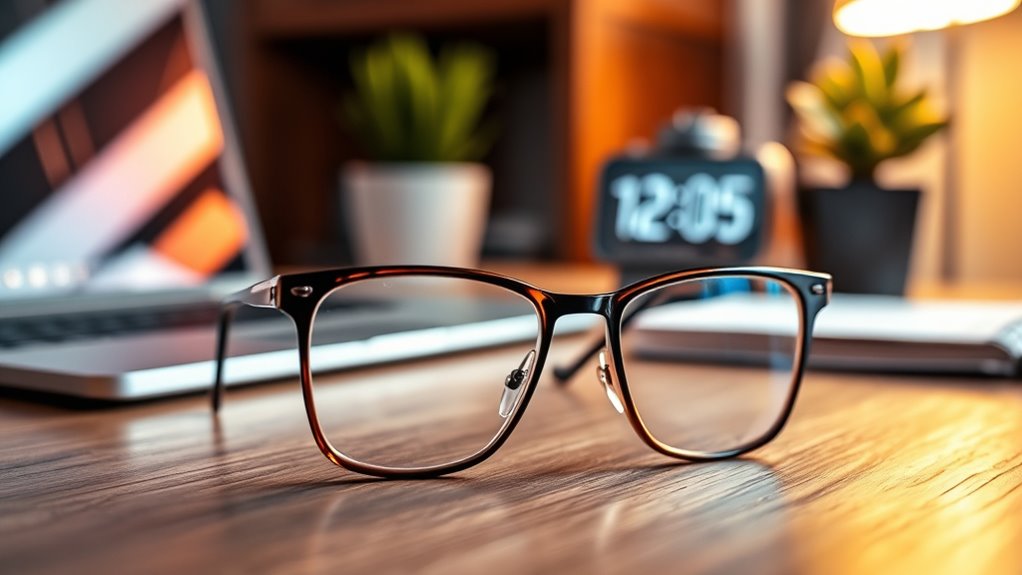
Deciding whether to use blue-blocking glasses depends on your daily habits and specific concerns. If you spend long hours in front of screens or experience sleep issues, they may help. Consider their role as fashion accessories, which can complement your style while providing eye protection. When choosing glasses, look into manufacturing processes that guarantee quality, such as lens coatings that effectively filter blue light without distorting color perception. Use them mainly in the evening or during prolonged screen use to reduce eye strain and improve sleep quality. However, if your screen time is minimal or you don’t notice discomfort, they might not be necessary. Ultimately, evaluate your routines and preferences to decide if blue-blocking glasses are a practical addition to your daily life.
Future Directions in Blue Light and Eye Health Research
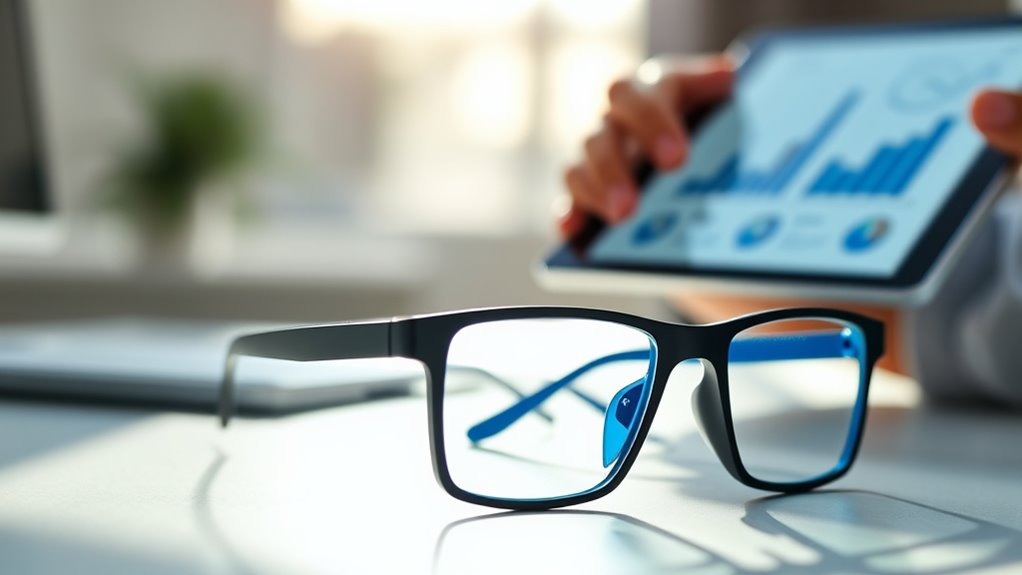
Advances in technology and growing awareness of blue light’s effects are shaping the future of eye health research. Researchers will likely focus on how technological innovation can improve blue light filtering devices and assess their real-world benefits. You can expect studies to explore how consumer perception influences the adoption of blue-light-blocking products and whether this impacts eye health outcomes. Future directions might include personalized blue light exposure assessments and wearable devices that monitor eye health in real time. Understanding the long-term effects of blue light exposure will be critical, as will developing evidence-based guidelines for usage. The integration of advanced imaging and data analytics will help clarify blue light’s true impact, guiding both consumers and clinicians toward more informed decisions.
- Development of smarter, more effective blue light filters
- Enhanced public education on blue light effects
- Long-term studies on blue light exposure impact
- Personalized eye health monitoring technologies
- Improved understanding of consumer perception and behavior
Frequently Asked Questions
Are There Any Long-Term Health Risks Associated With Blue-Blocking Glasses?
You might wonder about long-term safety and retinal health when using blue-blocking glasses. Currently, research shows no significant long-term risks associated with their use, and they may protect your eyes from potential blue light damage. However, it is crucial to use them responsibly and not rely solely on them for eye health. Regular eye check-ups and proper lighting habits remain essential to maintaining your retinal health over time.
How Do Blue-Light Effects Vary Among Different Age Groups?
You might think blue light affects everyone the same, but that’s far from true. Age-related sensitivity varies wildly, with children’s developing eyes more vulnerable to blue light damage, while adults often experience less impact. Developmental differences mean young eyes absorb more blue light, making blue-blocking glasses potentially more beneficial for kids. As you age, your eyes become less sensitive, so the effects diminish, but overall, age influences how blue light impacts your vision and sleep.
Can Blue-Blocking Glasses Improve Productivity Beyond Sleep Benefits?
You might find blue-blocking glasses can boost your productivity by enhancing focus and cognitive function. By reducing blue light exposure during work, especially in late hours, you can minimize eye strain and mental fatigue. This creates a clearer mental state, helping you stay alert and improve your concentration. Although sleep benefits are well-known, these glasses can also support cognitive enhancement and focus improvement during demanding tasks.
Are There Specific Brands or Types of Blue-Blocking Glasses Proven More Effective?
You wonder whether certain brands or types of blue-blocking glasses work better. Brand efficacy varies, so it’s wise to research reviews and scientific studies for specific options. Lens tinting intensity also matters; darker tints block more blue light but may affect color accuracy. Look for reputable brands with proven track records, and choose a lens tinting level that balances blue light protection with visual comfort for your needs.
What Are Alternative Methods to Reduce Blue Light Exposure Besides Glasses?
You might think glasses are your only option, but there are other effective ways to cut blue light exposure. Using screen filters can block blue light directly on your devices, and adjusting ambient lighting reduces overall eye strain. Combining these methods helps protect your eyes without relying solely on glasses. By controlling screen brightness and time, you can minimize blue light’s impact and improve your sleep and eye comfort.
Conclusion
So, while blue-blocking glasses act like a gentle sunset for your eyes, they aren’t a magic wand. They can help you sail calmer seas through digital storms, but they’re not the only lighthouse guiding your sleep and eye health. Use them wisely, like a trusted compass, and stay informed about the latest research. Your eyes deserve thoughtful navigation—after all, your vision’s future is worth the journey.
